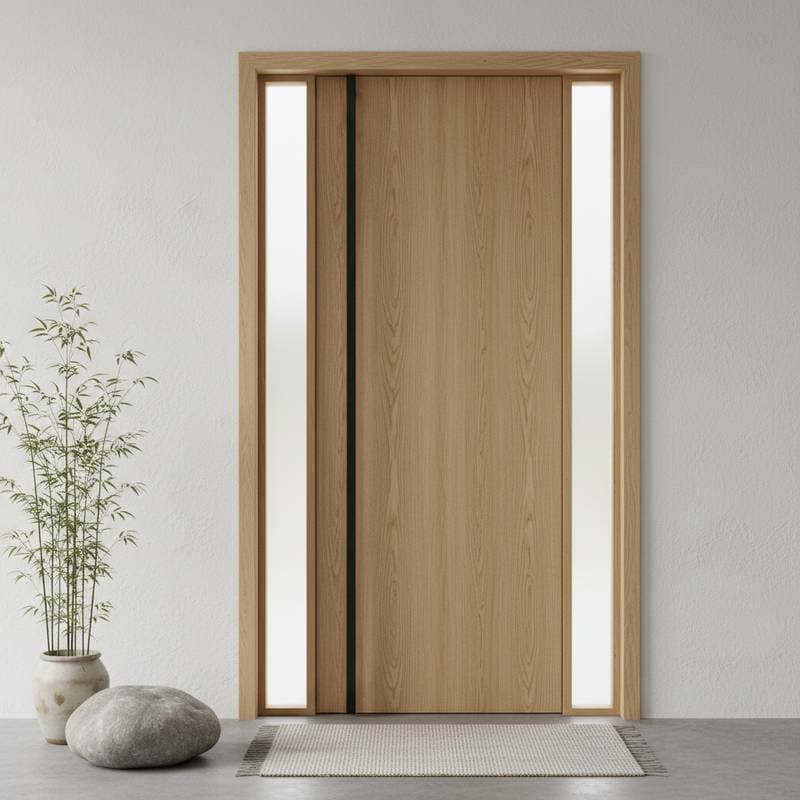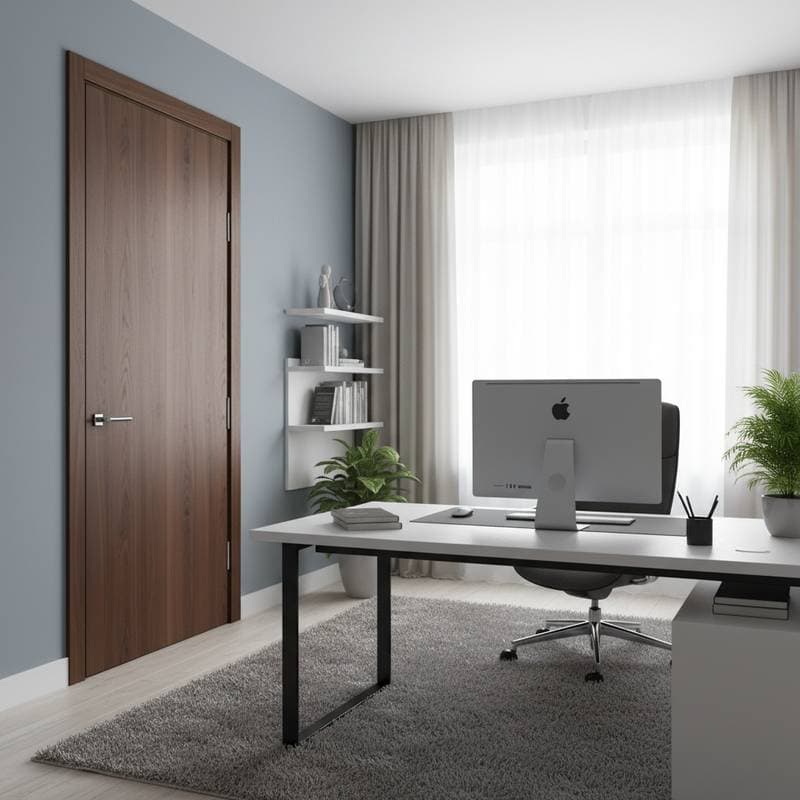Japandi Minimalist Entry Doors: Calm Precision Meets Natural Warmth
Japandi design gains prominence through its equilibrium of Scandinavian simplicity and Japanese serenity. The aesthetic appears calm, deliberate, and rooted in superior craftsmanship. Applied to entry doors, this approach generates a welcoming initial impression that integrates natural materials with precise geometry. The outcome produces an entryway that conveys peace and refinement, linking indoor tranquility with outdoor architectural coherence.
Three Approaches to Achieve This Aesthetic
Budget-Friendly Approach ($1,000 - $2,500)
- Select engineered wood doors featuring smooth veneers in light oak, ash, or maple to maintain affordability while preserving natural appeal.
- Pair with matte black or brushed nickel levers for hardware that aligns with minimalist principles without increasing expenses.
- Paint the frame in a subtle neutral tone, such as limestone gray or natural beige, to introduce gentle contrast.
- Allocate resources to a premium clear finish that accentuates wood grain depth and shields against moisture exposure.
Mid-Range Approach ($2,500 - $4,500)
- Choose solid wood varieties like white oak or bamboo composites oriented with horizontal grain for a contemporary edge.
- Incorporate vertical slats or understated paneling that nods to Japanese shoji influences while adhering to minimalist restraint.
- Integrate sidelights or slim glass inserts to enhance natural light inflow without compromising privacy.
- Elevate with hardware in satin brass or graphite finishes to provide organic, modern accents that harmonize seamlessly.
Premium Investment Approach ($4,500 - $8,000)
- Commission a bespoke door using rift-cut oak, walnut, or charred cedar, drawing from the Japanese yakisugi preservation method for durability and character.
- Apply handcrafted stains that emphasize inherent wood variations instead of uniform coloring.
- Install concealed hinges and pivot mechanisms to achieve a flush, architecturally precise appearance.
- Select artisanal bronze handles or simple wood pulls engineered to develop a patina over time.
- This level of investment yields enduring benefits through exceptional craftsmanship, improved thermal performance, and lasting stylistic relevance.
Material and Finish Selection Guide
-
Windows: Select slim-profile aluminum or wood-clad frames with clear or frosted glass panels. Frames in black, graphite, or natural timber complement Japandi doors effectively. Employ minimal grid patterns or forgo them to ensure unobstructed sightlines.
-
Doors: Prioritize flat-panel or slatted wood constructions in light to medium tones. Finishes such as natural oak, bleached birch, or smoked walnut strike the ideal equilibrium between warmth and subtlety. Hardware must feature clean lines and tactile surfaces to remain unobtrusive.
-
Siding: Pair horizontal wood cladding or fiber cement panels in soft grays, driftwood shades, or warm beiges. Vertical board arrangements can mimic Japanese joinery for added texture without excess.
-
Trim and Accents: Employ minimalist casing that matches the siding tone or varies by one shade darker. Add a modest overhang or pergola to temper the door lines and safeguard the entry from elemental wear.
Essential Maintenance Considerations
Natural materials demand attentive care, and Japandi exteriors rely on finishes designed to mature elegantly. Light woods necessitate UV-resistant sealants to avert color fading. Clear coatings require renewal every two to three years in regions with intense sunlight or frequent precipitation. Engineered composites and products minimize routine maintenance yet may sacrifice the tactile authenticity of solid wood. Clean metal hardware with mild soap solutions and apply lubricant periodically to inhibit corrosion. Conduct regular checks on weatherstripping to preserve crisp lines and prevent distortions or drafts.
Common Pitfalls to Avoid
-
Excessive Door Embellishment: Elaborate carvings, decorative glass, or vivid color applications undermine the serene equilibrium essential to Japandi. Maintain purity by emphasizing proportion and material integrity.
-
Overlooking Local Climate in Material Choices: Designs suited to arid environments may distort in humid settings. Select wood species or composites compatible with regional weather patterns.
-
Compromising on Finish Durability: Inexpensive stains and sealants degrade quickly, resulting in uneven surfaces. Invest modestly in superior products for enhanced protection and visual consistency over time.
-
Inconsistent Trim and Hardware Pairings: Uniform color schemes prove crucial. Refrain from combining warm bronze elements with cool gray exteriors to eliminate discordant visual effects.
Coordinating Colors and Styles
Japandi palettes excel with subdued natural hues and gentle contrasts. The following combinations foster unified elegance:
- Natural Oak Paired with Warm Gray and Matte Black for balanced depth and clarity.
- Bleached Ash Combined with Soft White and Graphite Hardware for a light, contemporary atmosphere.
- Smoked Walnut with Taupe and Bronze Accents for an anchored, refined presence.
- Charred Cedar Alongside Sandstone and Brushed Nickel for a grounded, structural declaration.
These selections prioritize texture and material nuances over dramatic chromatic changes.
Pre-Planning Photography and Assessment Checklist
Prior to finalizing door and finish decisions, compile references and evaluate site specifics:
- Capture current exterior images from frontal, angled, and detailed perspectives to assess scale and illumination.
- Document architectural features like roof profiles, window configurations, and porch structures.
- Review neighborhood guidelines or HOA regulations that constrain color or material selections.
- Analyze local climate factors, including coastal influences, temperature fluctuations, or rainfall patterns.
- Define budget allocations, pinpointing areas for aesthetic emphasis versus performance or upkeep priorities.
Crafting a Timeless Entryway
A Japandi minimalist entry door ushers tranquility into daily life. It positions the home threshold as a transitional space, providing a subtle interlude between external bustle and internal repose. This philosophy flourishes with authentic materials, restrained finishes, and details that honor natural proportions. Homeowners realize serene entryways through deliberate selections and proactive maintenance, blending practicality with enduring comfort and authenticity.






